Medals relating to New York City
As always, you can click or tap medals to see the reverse. Some medals might have multiple variants that differ in material, size, or other details. If multiple variants are available you can drag or slide medals sideways to display them.
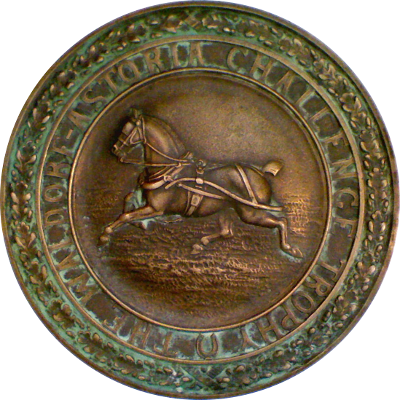

This medal's obverse bears a carriage horse in harness facing left in center field. Around, THE WALDORF-ASTORIA CHALLENGE TROPHY (horseshoe), surrounded by outer border of leaves.
The reverse bears engraved dedication surrounded by leaf border: · FOR · THE · BEST · HORSE · / · SUITABLE · FOR · A · GIG · / · owners to drive · / · DEALERS BARRED · / · WON BY · / · LORD BRILLIANT · / · H · C · HOSKIER · / · 1900 ·
At the turn of the 19th century both horses and clubs were important to one's social standing. It is no surprise that there were a variety of clubs centering on horses that allowed the animals' wealthy owners to compete for honors in various areas. Racing was always popular but in New York City one of the most prestigious trophies to be awarded was the Waldorf-Astoria Challenge Trophy. Around 1900 the annual challenge drew hundreds of competitors who showcased their horses and competed for the $500 award and the honor of owning the best harness horse.
Lord Brilliant was a horse that totally dominated the competitive harness horse scene for the decades between 1900 and 1930 and achieved widespread international fame. He was called "Poetry in motion" and "the finest harness horse to ever step into the tanbark arena." Judges would sometimes just pin the winner's ribbon on him right away before judging the rest of the field. He retired from competition in 1935 in a touching ceremony in which a horseshoe made of hundreds of roses was placed over his neck while one of his stable mates trotted up to him and sketched a deep bow before him. All the while, thousands of spectators cheered and clapped.
This circular medal measures 105mm in diameter and was struck in bronze. It was probably manufactured by Tiffany & Co. but it is not marked such and I have no data in support of this theory beyond the opinion of the person who sold me the medal.
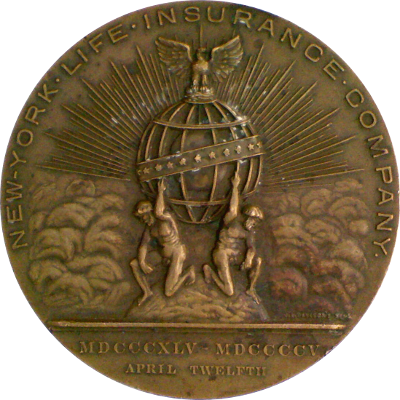

The medal's obverse bears eagle atop globe born by two nude men, clouds and sun rays behind. Around upper half, NEW-YORK LIFE INSURANCE COMPANY; in exergue, MDCCCXLV - MDCCCCV / APRIL TWELFTH; at right, J K DAVISON'S SONS.
The medal's reverse bears four medal images bearing company presidents over wreath around central medal image. From right, JAS.DeP.OGDEN 1845-1847; A.M.MERCHANT 1847-1848; MORRIS FRANKLIN 1848-1885; WM.H.BEERS 1885-1892; JOHN A. MCCALL 1892.
The medal's obverse at least borrows from August St. Gaudens' sculpture on top of the Kansas City headquarters of New York Life Insurance Company. The designer and sculptor of this medal are not known to me and any information would be appreciated.
This medal measures 76mm (3in) in diameter. It was struck by J.K. Davison's and Sons of Philadelphia.
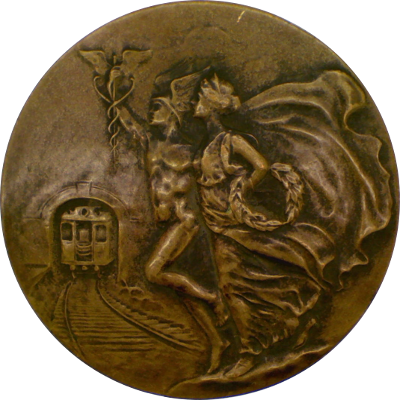
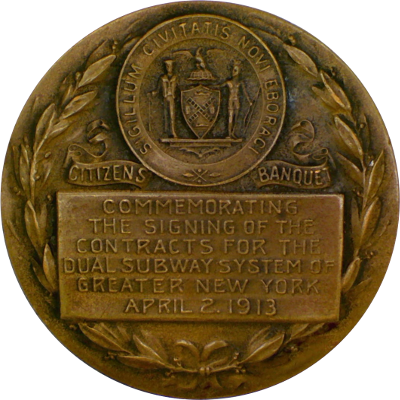
The obverse bears the seal of the city of New York in a wreath. Inscription reading CITIZENS - BANQUET / COMMEMORATING / THE SIGNING OF THE / CONTRACTS FOR THE / DUAL SUBWAY SYSTEM OF / GREATER NEW YORK / APRIL 2, 1913
The reverse bears Hermes, god of travel, conducting a female figure, representing the City, to an approaching subway train.
The banquet on April 2, 1913 capped a time of contentious negotiations, dealings and inter-burrough fighting over the layout and cost of new subway lines and the awarding of the operational contracts. At the banquet, city officials and taxpayers in favor if the chosen plans celebrated the signing of operations contracts for the subway line extensions.
As a keepsake, the guests of honor were handed this medal in gold, whereas regular diners were given a bronze version. While speakers widely praised the artistry of the medal, borough president McAneny caused a good deal of laughter when he speculated that the two figures on the medal were really Brooklynites who had lost their clothing when trying to get on one of the present subway trains during rush hour.
I have intentionally switched the obverse and the reverse images for this medal to show the beautiful, artistic side first. I don't usually do that but I agree with the banquet guests: this is a very artistic medal. I wish I knew the artist who created it. Please contact me if you have any knowledge you can share.
The circular medal measures 51mm in diameter and was struck in gold and bronze by the Whitehead & Hoag Company of Newark. The mintage is not reported.
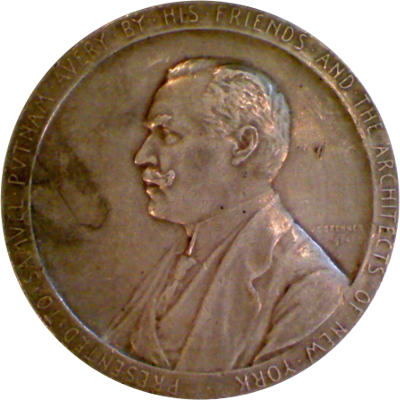

This medal's obverse bears portrait of Avery facing left. Around, · PRESENTED · TO · SAMVEL · PVTNAM · AVERY · BY · HIS · FRIENDS · AND · THE · ARCHITECTS · OF · NEW · YORK; signed over shoulder at right, V D BRENNER / 1914
The reverse bears view of building facade framed by trees and shrubs. Above, THE AVERY LIBRARY; below, framed by two wreaths, · FOVNDED · BY · / · SAMVEL · PVTNAM · AVERY · / · AND · MARY · OGDEN · AVERY · / · 1890 · / · COMPLETED · BY · / · SAMVEL · PVTNAM · AVERY · / · THEIR · SON · / · 1912 ·
The edge is marked TIFFANY & CO. FINE SILVER
The Avery Library is named for Henry Ogden Avery, one of late nineteenth century New York's promising young architects and a friend of William Robert Ware, who founded the Department of Architecture at Columbia in 1881. A few weeks after Avery's premature death in 1890, his parents, Samuel Putnam Avery and Mary Ogden Avery, established the library as a memorial to their son. They offered 2,000 of his books, mostly in architecture, archaeology, and the decorative arts, many of his original drawings, funds to round out the book collection, and an endowment to assure the continuous growth of the library.
The medal measures 64mm in diameter and was struck in silver by Tiffany & Company of New York City.
References: Smedley 102
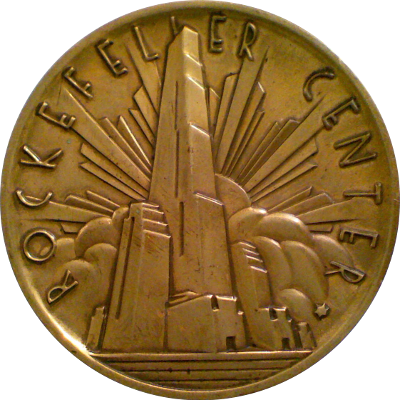
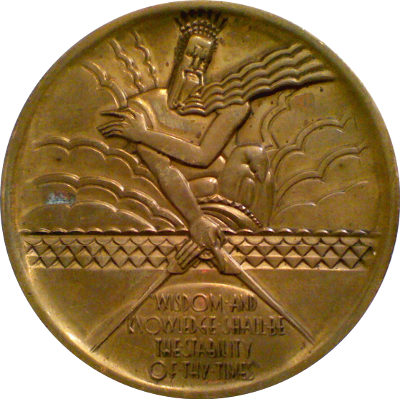
The obverse bears classic art deco view of building with sun behind and clouds on sides. Around, ROCKEFELLER CENTER.
The reverse bears medallic version of Lawrie's bas-relief panel on face of Rockefeller center. God with crown and long wavy beard frowning from sky. Below, WISDOM AND / KNOWLEDGE SHALL BE / THE STABILITY / OF THY TIMES.
The medal measures 70mm in diameter and was struck by the International Silver Company.
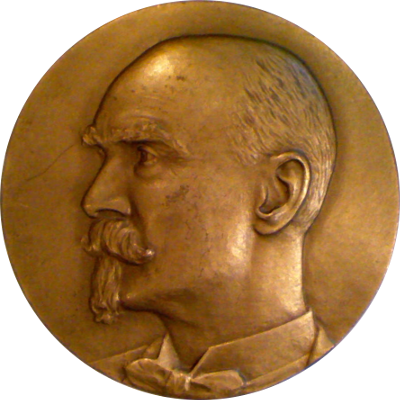
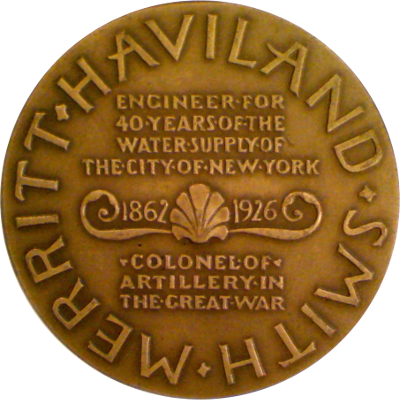
This medal's obverse bears portrait of Smith facing left.
The reverse bears text. Around, MERRIT · HAVILAND · SMITH ·; in center, ENGINEER · FOR / 40 · YEARS · OF · THE / WATER · SUPPLY · OF / THE · CITY · OF · NEW · YORK / 1862 (shell) 1926 / · COLONEL · OF · / ARTRILLERY · IN / THE · GREAT · WAR
Merrit Haviland Smith was born on May 21, 1862 in New York City. After an education in public schools and additional private tutors he graduated from the Pennsylvania Military College with a degree in civil engineering in 1880. After three years with the Pittsburgh and Western Railroad he joined the New York City Department of Public Works where he worked for the rest of his civilian life. In addition to his service as an Artillery Colonel in World War I, he also served with the New York National Guard in Puerto Rico from 1898 to 1899. He died in 1926.
This medal appears to be a copy of the bronze plaque erected in his memory at Kensico Dam shortly after his death in 1926.
The circular medal measures 50.4mm in diameter and was struck in bronze by the Medallic Art Company of New York. No mintage is reported.
References: MACo 1928-033


The medal's obverse bears boy painting poster with World's Fair motif in front of eagle. Around, NATIONAL POSTER COMPETITION.
The medal's reverse bears the New York World's Fair motif of trylon and perisphere. To left of trylon, 1939; across, N - EW YORK / WORLD'S / FAIR.
The National Poster Competition was officially announced on March 30, 1937 and was open to students throughout the United States. Participants could submit original poster designs for the New York World's Fair of 1939/40.
The medal was struck in bronze and silver, with the silver pieces being much rarer than those struck in bronze.
This medal measures 51mm (2in) in diameter and was struck by the Whitehead & Hoag Company of Newark, New Jersey.
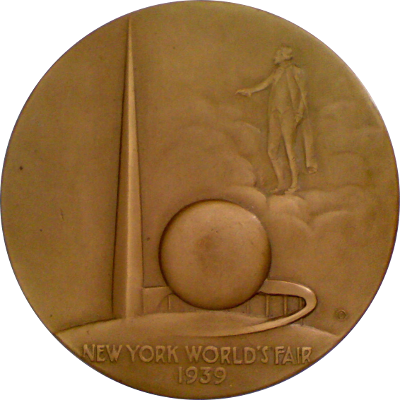

The obverse bears view of iconic Trylon and Perisphere; at upper right, a full length figure of George Washington emerges from cloud banks. At bottom, NEW YORK WORLD'S FAIR / 1939; at right, ©
The reverse bears three panels; top panel shows Trylon and Perisphere over radiant sun; above, THE WORLD OF TOMORROW; the middle panel shows view of Manhattan skyline as seen from the World's Fair grounds with legend TODAY; bottom panel shows view of New Amsterdam with legend YESTERDAY; signed at top right corner of bottom panel, KILENYI
The edge bears the marks ROBBINS CO. / ATTLEBORO - BRONZE.
This was the official medal of the New York World's Fair of 1939-40. The 190m-tall spire-shaped Trylon contained the (at the time) longest escalator and the 54m-diameter Perisphere housed a diorama called "Democracity" which depicted an topian city-of-the-future. A moving sidewalk transported spectators past the exhibits.
A much rarer version of the medal exists in which the year is 1940 rather than 1939.
The medal measures 63.5mm in diameter and was struck by the Robbins Company of Attleboro, Massachusetts.
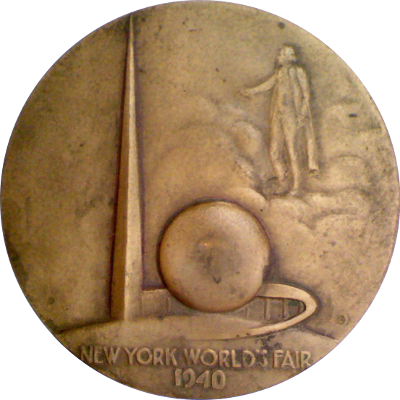

The obverse bears view of iconic Trylon and Perisphere; at upper right, a full length figure of George Washington emerges from cloud banks. At bottom, NEW YORK WORLD'S FAIR / 1940; at right, ©
The reverse bears three panels; top panel shows Trylon and Perisphere over radiant sun; above, THE WORLD OF TOMORROW; the middle panel shows view of Manhattan skyline as seen from the World's Fair grounds with legend TODAY; bottom panel shows view of New Amsterdam with legend YESTERDAY; signed at top right corner of bottom panel, KILENYI
The edge bears the marks ROBBINS CO. / ATTLEBORO - BRONZE.
This was the official medal of the New York World's Fair of 1939-40. The 190m-tall spire-shaped Trylon contained the (at the time) longest escalator and the 54m-diameter Perisphere housed a diorama called "Democracity" which depicted an topian city-of-the-future. A moving sidewalk transported spectators past the exhibits.
This is the much rarer version of the medal that shows the year as 1940 rather than 1939.
The medal measures 63.5mm in diameter and was struck by the Robbins Company of Attleboro, Massachusetts.

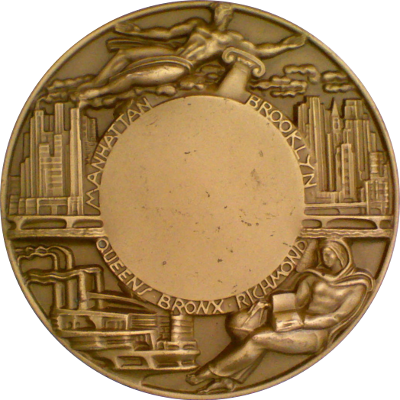
The obverse bears Art Deco style allegory depicting a kneeling female figure (representing the city) with five smaller figures (representing the five boroughs) standing on her extended leg. Around, GOLDEN ANNIVERSARY OF / THE CITY OF NEW YORK / 1948; signed along edge at 5:00 position: MICHAEL LANTZ.
The reverse bears flying male figure at top with skyscrapers below to either side; at bottom right, a reclining female figure holding book; at bottom left, a factory with smokestacks; at center, empty field surrounded by the names of the five boroughs: MANHATTAN BROOKLYN QUEENS BRONX RICHMOND.
The medal commemorates the City of New York's Golden Anniversary and was issued by the Mayor's Committee for the celebration. Shortly after the celebration, the medal was modified, replacing the "1948" date with five stars and replacing the two lines of text with one, and called "The Bronze Medallion." The Bronze Medallion is the highest award given to civilians by the City of New York and is used to this day.
This medal measures 70mm in diameter and was struck in bronze by the Medallic Art Company of New York.
References: Marqusee 236
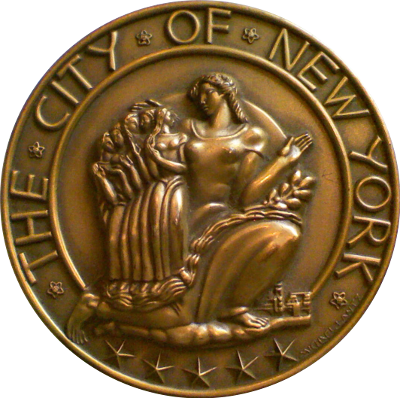
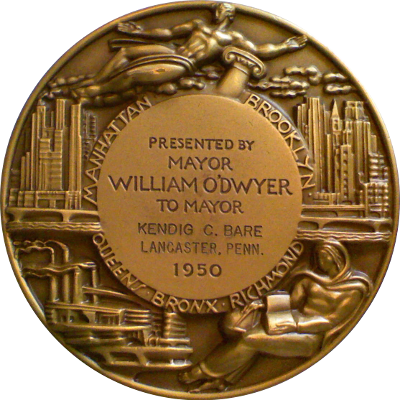
The obverse bears Art Deco style allegory depicting a kneeling female figure (representing the city) with five smaller figures (representing the five boroughs) standing on her extended leg. Around, THE CITY OF NEW YORK / * * * * *; signed along edge at 5:00 position: MICHAEL LANTZ.
The reverse bears flying male figure at top with skyscrapers below to either side; at bottom right, a reclining female figure holding book; at bottom left, a factory with smokestacks; at center, inscribed field surrounded by the names of the five boroughs: MANHATTAN BROOKLYN QUEENS BRONX RICHMOND. This piece contains inscription: PRESENTED BY / MAYOR / WILLIAM O'DWYER / TO MAYOR / KENDIG C. BARE / LANCASTER. PENN. / 1950
This medal is the highest award conferred upon civilians by the City of New York. The medal is presented by the Mayor to those individuals who have demonstrated, "exceptional citizenship and outstanding achievement."
The recipients come from a wide range of backgrounds, including ordinary citizens, foreign dignitaries, athletes, and film stars. The recipient of this particular piece was Kendig C. Bare, the mayor of Lancaster, Pennsylvania. He was mayor from 1950 to 1958 and served in the Korean War in 1950/1951. This particular piece seems to be one of the earliest because the medal was only designed in 1950. It is based on Michael Lantz's Golden Anniversary medal from 1948 and reworked into this design in 1950.
This medal measures 70mm in diameter and was struck in bronze by the Medallic Art Company of New York.
References: Marqusee 236
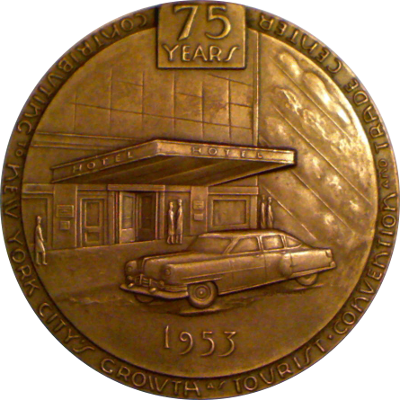

The obverse depicts 1950s street scene with car and generic hotel facade and people. Above, 75 / YEARS; below, 1953; around, CONTRIBUTING TO NEW YORK CITY'S GROWTH AS TOURIST CONVENTION AND TRADE CENTER
The reverse shows a 19th century street scene with old-style hotel facade and horse-drawn coach in front. Above, 75TH ANNIVERSARY; below, 1878; around bottom, HOTEL ASSOCIATION OF NEW YORK CITY
Established in 1878, the Hotel Association of New York City, Inc. is one of the oldest professional trade associations in the nation. As of 2015, its membership included more than 270 of the finest hotels in New York City, representing more than 75,000 rooms and approximately 50,000 employees.
The medal measures 70mm in diameter and was struck by the Medallic Art Company of New York.
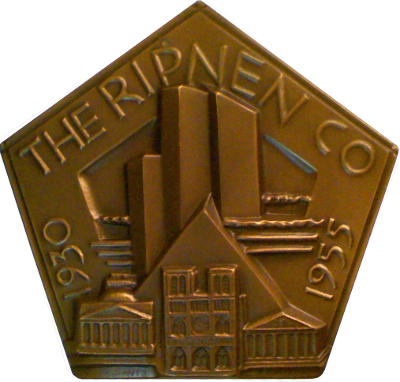
This uniface medal's obverse shows historic monumental buildings in front of modern skyscrapers breaking through layers of clouds. Above, THE RIPNEN CO; to left, 1930; to right, 1955; signed at lower left, LANTZ
TKenneth Ripnen was an architect in New York and wrote a book titled "Office Building and Office Layout Planning", in which he called for a wholly new conception of "space for the organization man." The basic idea was to optimize modern office buildings fo maximum productivity, a quest that continues to this day.
TThe medal celebrates the 25th anniversary of Ripnen's architectural firm.
This pentagonal medal measures 96mm x 91mm (60mm per side) and was struck in bronze by the Medallic Art Company of New York.
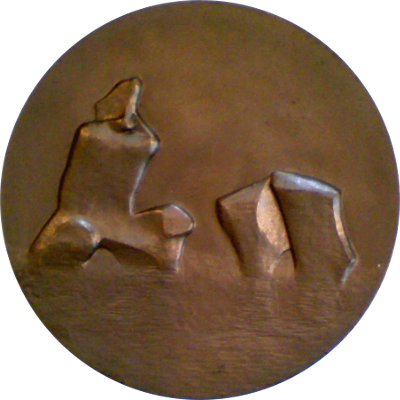
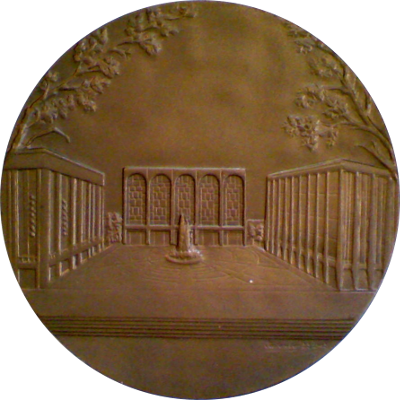
This medal's obverse bears Sir Henry Moore's Reclining Figure sculpture.
The reverse shows view of Lincoln Center with court yard and fountain.
The Lincoln Center for the Performing Arts was built as part of Robert Moses' program of urban renewal in the 1950s and 1960s. Civic leaders led by John D. Rockefeller III contracted famous architects to design Lincoln Center and rejuvenate and reenrgize the previously blighted neighborhood around Lincoln Square. Today, Lincoln Center hosts the New York Philharmonic, the Metropolitan Opera, and the New York City Ballet and the neighborhood is one of New York City's cultural hubs.
The medal celebrates the 10th anniversary of the opening of the complex's first building, the David Geffen Hall, in 1962.
The circular medal measures 76mm in diameter and was struck in bronze by the Medallic Art Company of New York. No mintage is reported.
References: MACo 1972-127